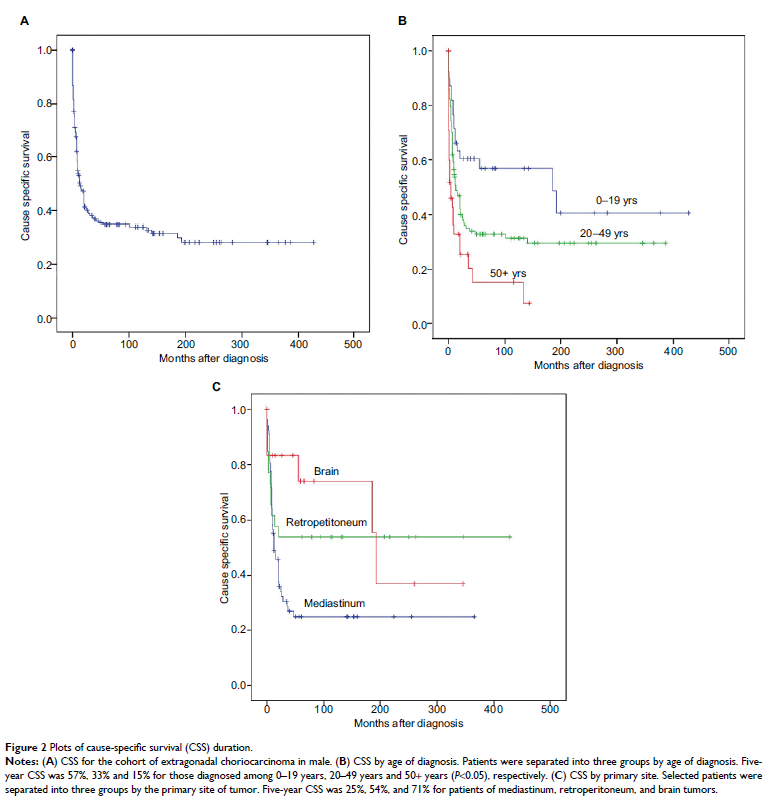108384
论文已发表
注册即可获取德孚的最新动态
IF 收录期刊
- 3.4 Breast Cancer (Dove Med Press)
- 3.2 Clin Epidemiol
- 2.6 Cancer Manag Res
- 2.9 Infect Drug Resist
- 3.7 Clin Interv Aging
- 5.1 Drug Des Dev Ther
- 3.1 Int J Chronic Obstr
- 6.6 Int J Nanomed
- 2.6 Int J Women's Health
- 2.9 Neuropsych Dis Treat
- 2.8 OncoTargets Ther
- 2.0 Patient Prefer Adher
- 2.2 Ther Clin Risk Manag
- 2.5 J Pain Res
- 3.0 Diabet Metab Synd Ob
- 3.2 Psychol Res Behav Ma
- 3.4 Nat Sci Sleep
- 1.8 Pharmgenomics Pers Med
- 2.0 Risk Manag Healthc Policy
- 4.1 J Inflamm Res
- 2.0 Int J Gen Med
- 3.4 J Hepatocell Carcinoma
- 3.0 J Asthma Allergy
- 2.2 Clin Cosmet Investig Dermatol
- 2.4 J Multidiscip Healthc

男性性腺外绒毛膜癌的发病率和预后因素:一个基于人口的研究
Authors Qiu J, Jia S, Li G
Received 31 May 2018
Accepted for publication 2 August 2018
Published 15 October 2018 Volume 2018:10 Pages 4565—4573
DOI https://doi.org/10.2147/CMAR.S175948
Checked for plagiarism Yes
Review by Single-blind
Peer reviewers approved by Dr Justinn Cochran
Peer reviewer comments 3
Editor who approved publication: Dr Antonella D'Anneo
Background: Choriocarcinoma usually occurs in females and sometimes occurs in
the testicles of males. Extragonadal choriocarcinoma in males was previously
described in case reports, and our understanding of this type of cancer has
remained limited. The purpose of this study was to explore the incidence,
treatment and prognostic factors of extragonadal choriocarcinoma in males.
Materials and
methods: Two cohorts were identified from the
Surveillance, Epidemiology, and End Results (SEER) Program by histology, tumor
site and sex. One cohort of 115 patients was created using the SEER nine
registries (1973–2014) to estimate the incidence. The other cohort of 197
patients was created using the SEER 18 registries (1973–2013) to estimate the
patient demographics and survival.
Results: The median age at diagnosis was 30 years. The most common primary tumor
location was the mediastinum followed by the retroperitoneum and the brain.
Approximately 23% of patients underwent beam radiation therapy, whereas 63.5%
underwent surgery. The estimated one- and 5-year cause-specific survival rates
were 49% and 35%, respectively. The multivariate analysis showed that the age
at diagnosis, ie, a younger age of 0–19 years old, and the primary tumor site,
ie, the brain, were the independent prognostic factors and were correlated with
a favorable prognosis. The median survival time of patients was 186 months, 13
months and 4 months in the 0–19, 20–49 and 50+ years of age, respectively.
Conclusion: Extragonadal choriocarcinoma in males is a rare malignancy with a
poor prognosis. A young age at diagnosis and primary tumor site in the brain
were the independent prognostic factors.
Keywords: choriocarcinoma, incidence, beam radiation, surgery, prognosis
